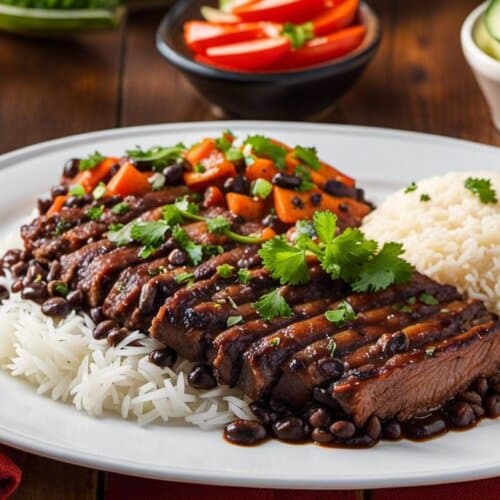WANT TO SAVE THIS RECIPE?
Enriched with traditional spices, smoky flavors, and a unique history, Carne Mechada takes its diners on a culinary journey to its roots in Latin America. This iconic dish, primarily native to Venezuela and Puerto Rico, holds a special place in the heart of Latin American cuisine, as its aroma wafts through the kitchens of generations who have cherished and preserved its preparation process. This article delves into the fascinating journey of Carne Mechada – from its historical backdrop to its preparation nuances. Whether you’re a food enthusiast eager to recreate this dish at home or simply interested in learning about its rich cultural significance, this exploration of Carne Mechada will serve a delightful course of wholesome knowledge.
Origins and History of Carne Mechada
Origins and Origins of Carne Mechada
Carne Mechada, a traditional dish deeply rooted in the culinary traditions of Latin America, finds its most notable origins in the cuisines of Venezuela and Puerto Rico. The literal translation of the term “Carne Mechada” is ‘stuffed meat,’ indicating the delightfully flavorful surprise that waits inside the pot roast, where the dish gets its name: it involves hollowing out a piece of beef and “stuffing” it with a variety of cooked and seasoned ingredients.
In its most traditional Venezuelan form, Carne Mechada is a fundamental part of a widely consumed national dish named Pabellón Criollo. This dish typically comprises shredded beef, black beans, rice, and plantains, representing the melting pot of culinary influences that is the national heritage of Venezuelan cuisine: European, Indigenous, and African traditions.
On the other hand, Puerto Rican Carne Mechada, also known as ‘Carne rellena’ (filled meat), is a cherished Christmas Eve food tradition. The culinary artistry involved in preparing Carne Mechada is assumed to be an influence of Spanish colonizers who brought the technique of stuffing meats to the Americas.
Carne Mechada: Distinctions and Evolution
With its roots reaching deep into many cultures and passed down through countless generations, Carne Mechada features a variety of preparation methods shaped by cultural distinctions, regional resources, and family traditions.
In the heart of Venezuela, the meat used in Carne Mechada traditionally undergoes boiling alongside a mix of aromatics to enrich the taste. The beef is then shredded and sautéd with onions, bell peppers, garlic, and tomato sauce. A common sight in Venezuelan cuisine, it is typically enjoyed stuffed in arepas or empanadas.
Alternatively, in Puerto Rico, Carne Mechada is more frequently prepared by filling an entire piece of meat, typically a flank steak, with a medley of ingredients such as Spanish chorizo, olives, and capers, resulting in a versatile blend of flavors. The beef is then slowly braised until it reaches an ideal tenderness and is generally served sliced, revealing the colorful stuffing, and paired with rice and beans.
Starting as a regional specialty in certain areas of Latin America, Carne Mechada has since gained global popularity. This is not only a reflection of the deep-rooted culinary heritage of its originating countries but also an iconic affirmation of how gastronomic customs adapt and evolve over time, transcending cultural borders and unifying various communities via shared meals.
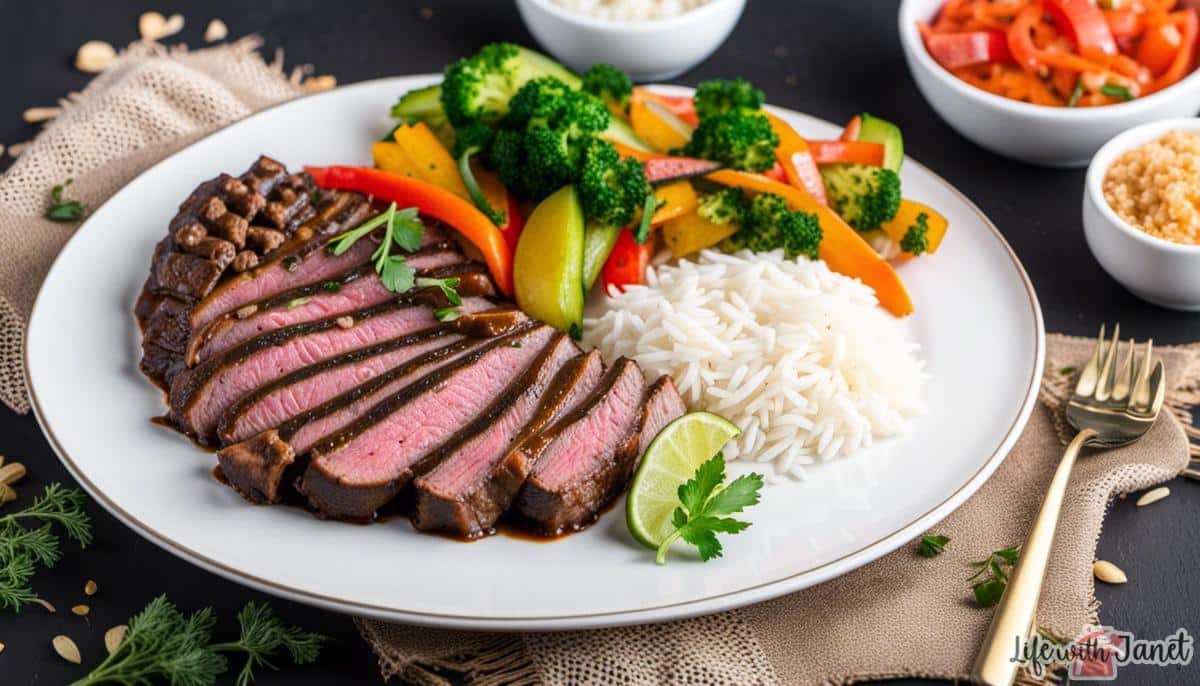
Preparation and Cooking Process
Introduction to Carne Mechada: A Revered Latin American Food Tradition
Carne Mechada, an eminent Latin American delicacy, is a frequent highlight in numerous family festivities and special events. Although its origins can be traced back to Spain, it has significantly evolved over centuries and has now established its sustained presence as a cherished staple in countries like Venezuela and Puerto Rico.
Key Ingredients for Carne Mechada
Ideal for feeding large groups, Carne Mechada is usually prepared with a beef roast, typically a rump or a round roast – but any large, lean cut will do. The meat is then stuffed or “mechada” with a mix of colorful ingredients: typically a combination of garlic, bell peppers, onions, olives, and occasionally, hard-boiled eggs.
The dish also calls for a list of additional spices, including cumin, oregano, bay leaves, salt, and pepper, along with olive oil and vinegar, which create the signature fragrance and taste associated with Carne Mechada. To wrap up, tomato sauce and wine are often included in the recipe for added depth and richness.
Cooking Process for Carne Mechada
The process to cook Carne Mechada traditionally involves several steps. It begins with making a deep incision in the roast to create a cavity, which is then filled or “stuffed” with the olive, bell pepper, and garlic mixture – hence the name “mechada,” which translates to “threaded.”
Once the beef is filled, it is then typically seared in a sizeable heavy-bottomed pot or dutch oven. After it is sufficiently browned, the beef, along with the remaining stuffing, is added back to the pot. Additional ingredients, such as wine and tomato sauce, are then added to impart layers of flavor.
The dish requires slow and long cooking. The beef is simmered on low heat for several hours until it becomes tender and absorbs all the delicious flavors from the mixture. After it’s done, the meat is shredded and can be served with rice or stuffed into arepas or empanadas – a perfect, hearty dish that truly pays homage to its rich Latin American heritage.
Key Tips for Cooking Carne Mechada
When cooking Carne Mechada, a beloved dish from Latin American cuisine, it’s important to keep a few key tips in mind in order to achieve superior taste and texture. Always start with a high-quality, lean cut of beef to ensure a rich and flavorful outcome. Be careful not to overstuff the meat, allowing all the ingredients to effectively combine and infuse the roast during the slow-cooking process.
An essential step to unlocking the depth of flavor in Carne Mechada is to sear the meat prior to slow-cooking. This helps to form a delicious crust and enhances the dish’s overall savoriness. Slowly cooking the beef at low heat enables it to break down and become wonderfully tender and juicy. Be sure to use fresh ingredients whenever possible, as they contribute a robustness to the flavor profile that canned or dried items cannot match.
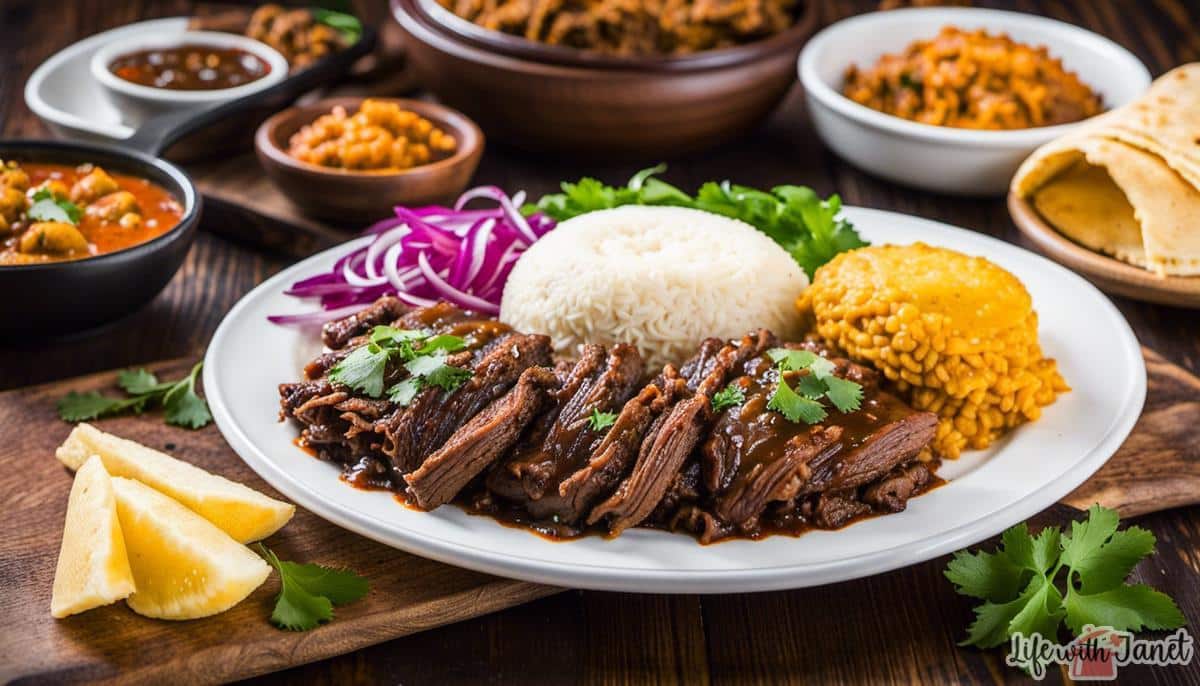
Serving and Pairing Suggestions
Traditional Ways of Serving Carne Mechada
The aromatic and succulent Carne Mechada, steeped in a medley of vegetables and spices and slow-cooked to perfection, is a revered dish in Latin American kitchens. Its bold flavor makes it a versatile centerpiece for any meal, and it pairs remarkably well with a wide variety of side dishes and beverages. No matter how you serve it, Carne Mechada is sure to delight the taste buds and transport you to the vibrant culinary landscape of Latin America.
Traditionally, Carne Mechada is often served with a side of rice or arepas
(a type of bread made from ground maize dough or cooked flour), and black beans. This starchy complement helps soak up the flavorsome gravy, adding an element of comfort to the dish. It may also be accompanied by sweet plantains or yuca
a relative of the potato common in Latin America, adding a touch of sweetness to balance the savory taste of the meat.
Pairing Beverages with Carne Mechada
In terms of beverages, this robust and hearty dish complements well with robust red wines. A Cabernet Sauvignon or a Spanish Rioja, with their deep flavors and high acidity, can cut through the richness of the dish, enhancing its gratifying flavors.
Alternatively, for non-alcoholic options, passion fruit juice or other tropical fruits juices are commonly served. These fruit juices provide a refreshing contrast to the substantial nature of Carne Mechada.
Cultural Preferences in Serving Carne Mechada
Cultural preferences naturally play a significant role in how Carne Mechada is served. In Venezuela, where it’s considered a national dish, it’s a key component of Pabellon Criollo – a platter that includes shredded beef, black beans, rice, and fried plantains. On the other hand, in Puerto Rico, it’s routinely used as a filling for empanadas and sandwiches.
Adapting Carne Mechada for Dietary Requirements
Adaptability is another key advantage in serving Carne Mechada. For those with dietary restrictions, substitute the beef for jackfruit or mushrooms for a vegetarian or vegan alternative, or adjust the seasonings to be gluten-free.
Exploring the Delights of Carne Mechada
The culinary world of Carne Mechada presents a fantastic opportunity to delight in a range of flavors and cultural subtleties. Whether savored alongside a strong red wine and rice, or enjoyed as a part of a substantial sandwich, this flexible dish is sure to win over diners and infuse the essence of Latin American cuisine onto any dining table.
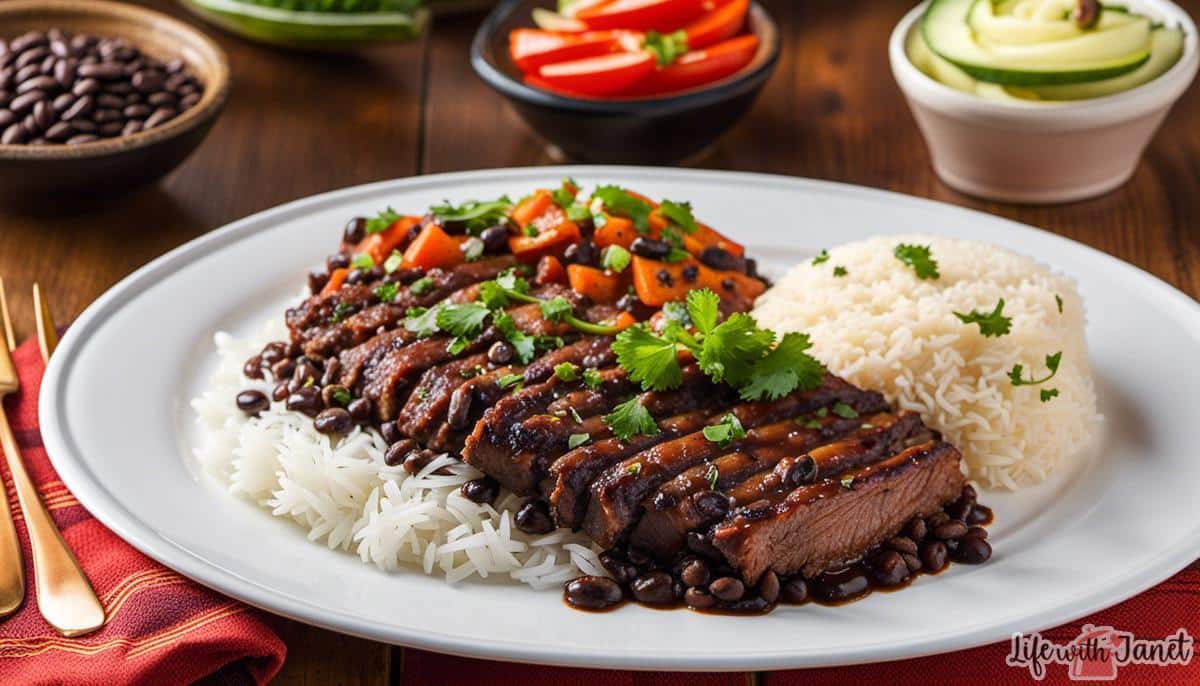
Popular Variations and Adaptations
Global Interpretations of Carne Mechada
Carne Mechada’s versatility has led to it being embraced and customized by cultures across the globe, each infusing it with its unique regional flair. In Spain, for example, Carne Mechada is traditionally prepared using a lean beef cut such as brisket or chuck roast, often stuffed with chorizo or other cured meats. Contrastingly, the Venezuelan version uses shredded beef, peppers, tomatoes, and onions. The Cuban variant, commonly known as Ropa Vieja and hailed as Cuba’s national dish, calls for ingredients like flank steak, tomatoes, bell peppers, onions, and olives.
Modern Adaptations of Carne Mechada
In the modern culinary sphere, many chefs and home cooks have incorporated their take on Carne Mechada by adding unique elements or tweaking the classic recipe to better fit contemporary palate profiles. For instance, some have replaced traditional stuffing ingredients with modern substitutes like lab-grown meats or plant-based proteins. Others have experimented with international flavors, adding components such as coconut milk, soy sauce, or Sriracha to present a fusion cooking version of the dish.
Dietary Restriction-Friendly Options
Carne Mechada need not be off-limits for individuals adhering to specific dietary restrictions. For those following a gluten-free diet, make sure the broth or stock used is gluten-free. For those adhering to a low-fat diet, opt for lean cuts of meat, and limit the amount of added oil.
Substituting beef with leaner meats like chicken or turkey can also create a healthier version of the dish. There’s a proliferation of plant-based meat substitutes in today’s market that can be used to cater to vegetarians or vegans. To keep the recipe flavorful, incorporate a variety of spices and herbs, and increase the quantity of healthful ingredients such as tomatoes, bell peppers, and onions.
However, making significant changes to traditionally meat-centered dishes like Carne Mechada can alter the taste and texture significantly, hence it’s important to adjust expectations and appreciate these variations as an inventive spin on the traditional recipe rather than a direct substitution.
Whether you prefer a traditional Carne Mechada or revamped regional and dietary versions, this versatile dish undoubtedly has a variant to suit all preferences and palates.
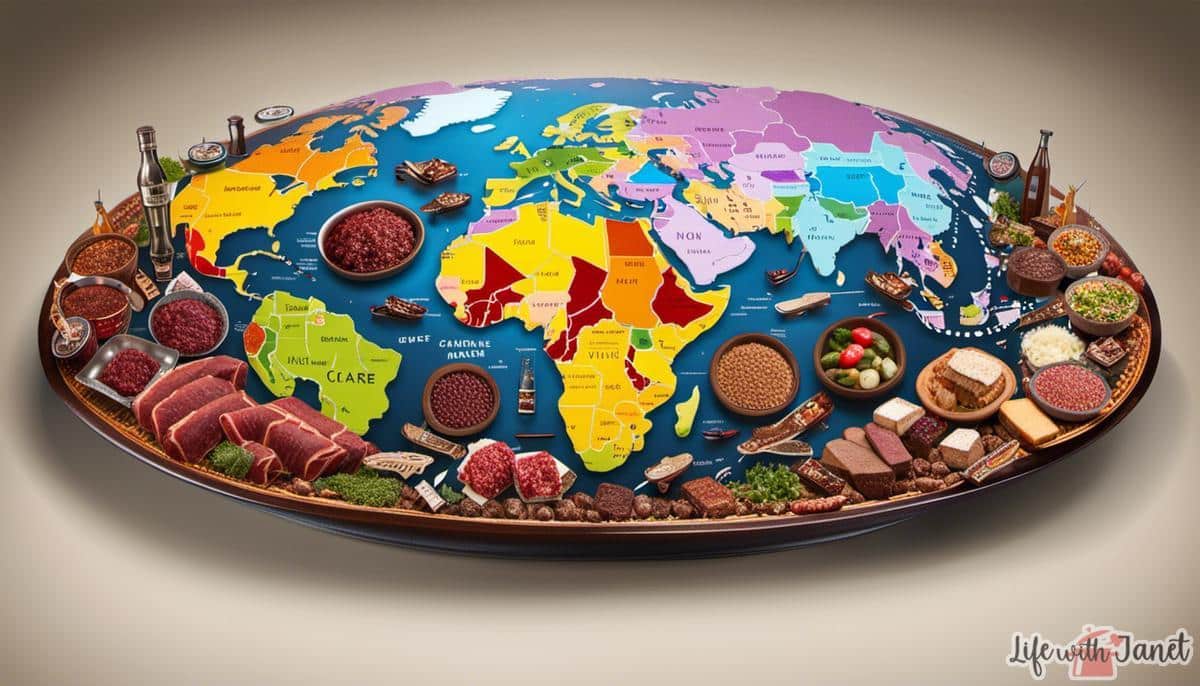
As you peruse through the cultural landscape of Carne Mechada, it’s remarkable to witness how a cherished family recipe has moved beyond its traditional borders to find a place in global cuisine. The diverseness in its preparation and the flexibility of pairing it with a host of sides and beverages, make it not just an exotic dish, but a testament to culinary adaptation and innovation. Dishes like Carne Mechada continue to deepen our understanding of how food speaks a universal language, bridging cultures and generations along its journey. So be it a hearty family dinner or a cultural exploration through food, may the flavors of Carne Mechada inspire you to create, innovate, and appreciate the rich tapestry of culinary heritage.
Carne Mechada
Ingredients
- 1-2 lb skirt or flank steak
- 6-8 cups beef broth ain’t no shame in store-bought
- A dash of salt and pepper or however y’all like it
- 4 tablespoons olive oil get the good stuff
- 1 cup onion all chopped up
- 1 cup green bell pepper diced
- 3 garlic cloves minced (more if you’re feelin’ wild)
- 1 can 6oz tomato paste
- 1 can 8oz tomato sauce
- A splash of Worcestershire sauce
- 2 teaspoons ground cumin
- A pinch of dried oregano
- 2 bay leaves for a lil’ extra somethin’
Instructions
- First off, cut that meat into 4 solid pieces.
- Heat that beef broth in a big ol’ pot. Once it’s bubblin’, toss in the meat. Let it sizzle for 15 minutes. Give it a taste and season accordingly. Let it simmer for a good 2-3 hours till that meat’s fall-apart tender. Make sure the meat’s always submerged.
- Once that meat’s done, get it out, set it aside to cool down a bit, and save that broth.
- When the meat ain’t too hot, shred it up, gettin’ rid of any unwanted fat.
- Get your skillet hot, pour in that oil, and toss in your onions and peppers. Once those onions look clear, throw in the garlic for a minute.
- Mix in that shredded beef.
- In a bowl, stir together your tomato stuff, Worcestershire, cumin, oregano, and some of that saved broth. Add it to your skillet, throw in the bay leaves, and let it cook down for 20-25 minutes. Season as you like.
- Serve it up with rice, beans, and those crispy plantains if you’re into that.
For Y’all Slow Cooker Lovers:
- Season that meat and get it into the slow cooker.
- Mix beef broth, tomato paste and sauce, Worcestershire, cumin, and oregano in a bowl and pour it over the meat.
- Add your onions, peppers, garlic, and bay leaves. Mix it up real good.
- Let it cook LOW and slow for 6-8 hours or on HIGH for a quicker 3-4 hours.
- Once it’s all tender and juicy, get that meat out, shred it, and ditch any chunky fat. Mix it back into the sauce, toss out those bay leaves.
- Plate it with rice, beans, and fried plantains if that’s your jam.

